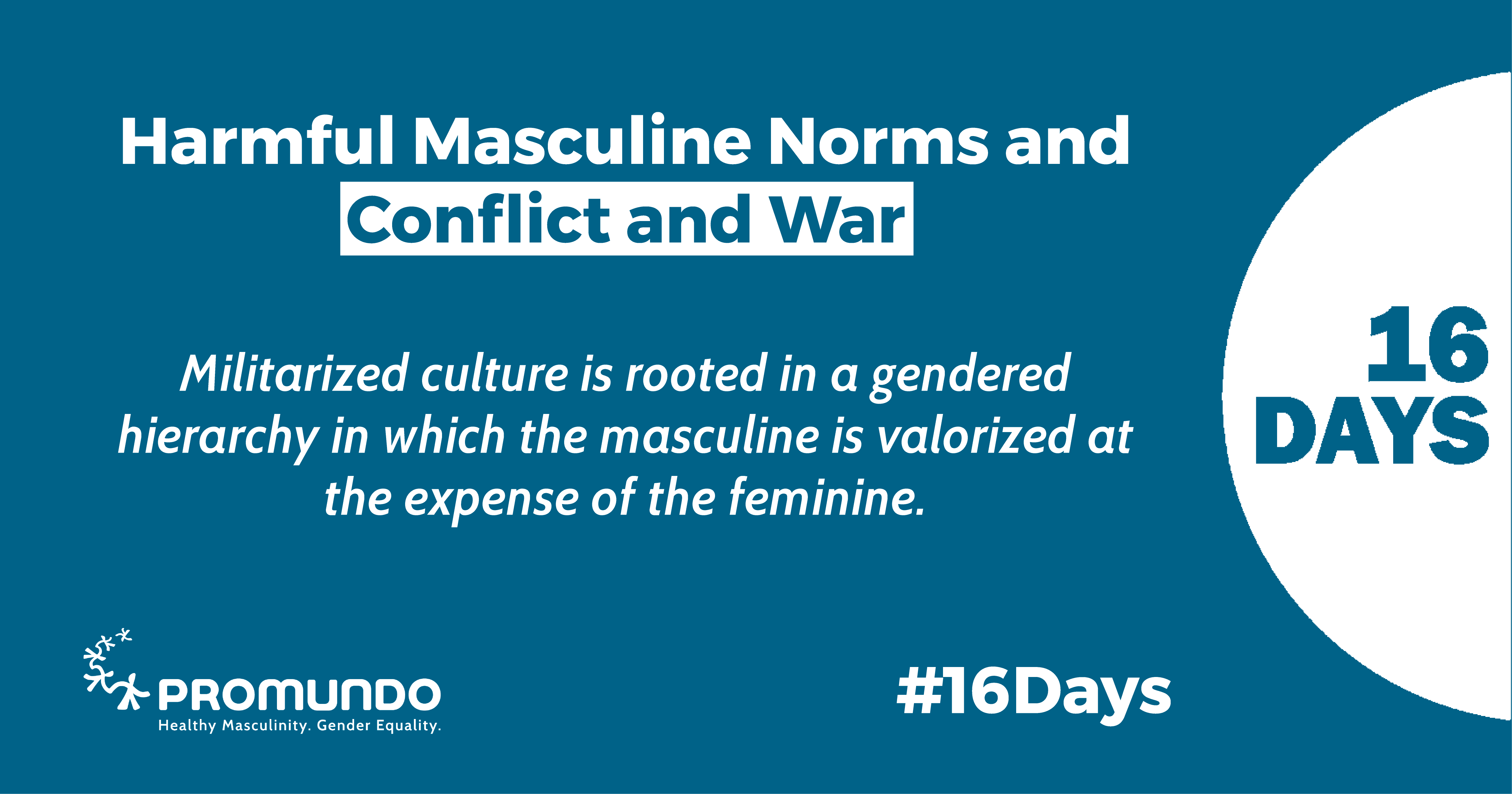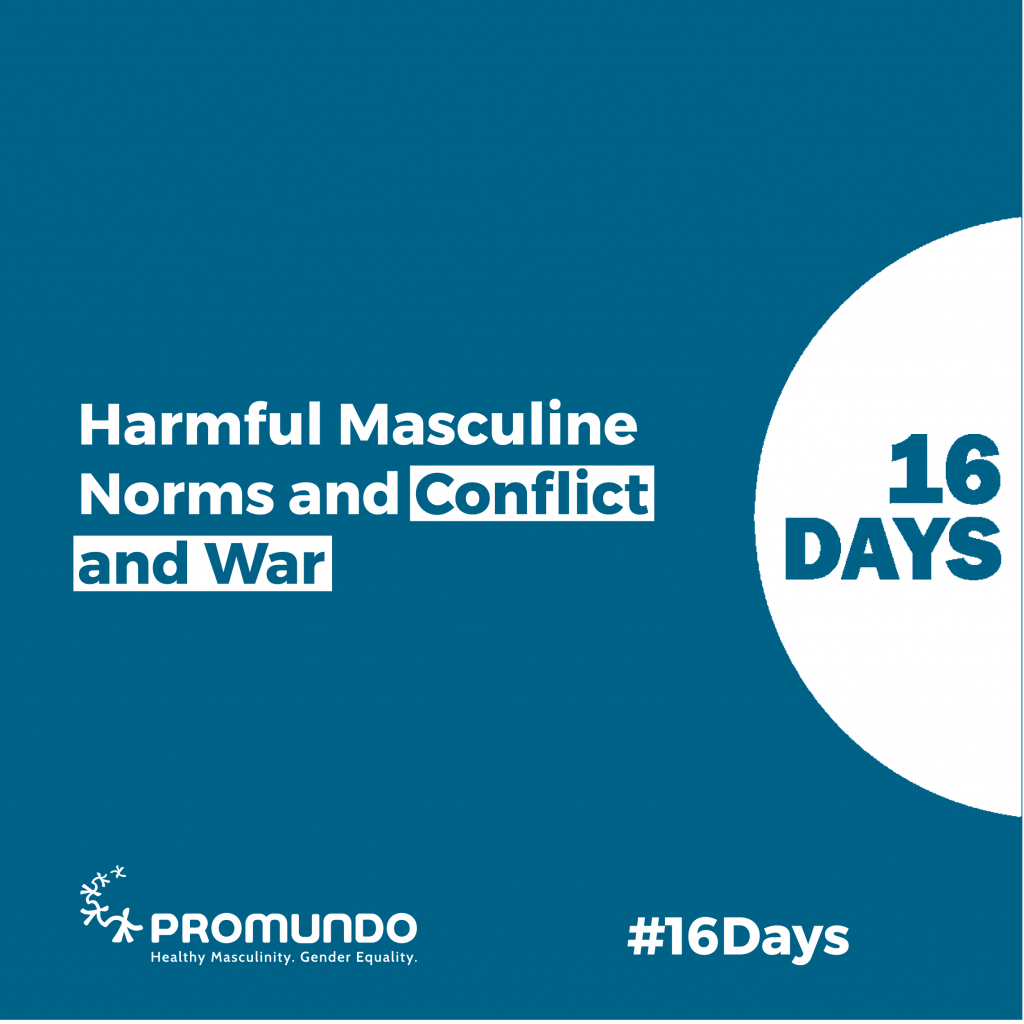Os 16 Dias de Ativismo Contra a Violência de Gênero são uma campanha internacional usada por ativistas ao redor do mundo (25 de novembro a 10 de dezembro) como uma estratégia de organização para pedir a eliminação de todas as formas de violência de gênero.
Este ano, compartilharemos pesquisas sobre as ligações entre normas masculinas prejudiciais e oito formas diferentes de comportamento violento, bem como insights e recomendações para eliminar todas as formas de violência.

Embora não haja nada inerente ao fato de ser homem que impulsione a violência, a maneira como socializamos os meninos em suas identidades como homens e o que esperamos deles — isto é, as normas masculinas da sociedade — estão inegavelmente ligados à violência.
De fato, meninos e homens são frequentemente criados, socializados e incentivados a usar a violência de alguma forma; em geral, homens e meninos têm uma probabilidade desproporcional de perpetrar a maioria das formas de violência e de morrer por homicídio e suicídio. No entanto, a pesquisa afirma que essa violência é prevenível, a igualdade de gênero é alcançável e normas e ideias não violentas sobre masculinidade são predominantes e poderosas.
Relatório da Equimundo e da Oak Foundation Normas Masculinas e Violência: Fazendo as Conexões, examina as ligações entre normas masculinas nocivas e oito formas de comportamento violento. Este oitavo e último blog da série Fazendo as conexões, 16 Dias de Ativismo A série se concentra em conflitos e guerras. Ela analisa os fatos sobre conflitos e guerras, explora suas ligações com outras formas de violência e fornece recomendações para ação.
Conflito e Guerra
Os fatos
Homens têm uma probabilidade desproporcionalmente maior de morrer como resultado direto de conflitos armados em comparação com mulheres. No entanto, essas mortes violentas não são as únicas – nem mesmo uma grande parte – das mortes associadas a conflitos ativos, e alguns dados sugerem que a maioria das mortes associadas a conflitos ativos – quando consideradas as consequências indiretas – são de mulheres e crianças.
O envolvimento em forças armadas ou milícias também é inegavelmente masculino. Mesmo entre homens que se alistam voluntariamente nas forças armadas ou se juntam a uma milícia ou grupo rebelde, existe uma certa dose de coerção enraizada no potencial acesso à masculinidade dominante, poderosa e privilegiada.
Os Links
Alguns estudiosos sugerem que a exclusão social dos jovens, e não sua natureza inerente ou seu número, pode levá-los a comportamentos violentos.
Violência, conflito e guerra não estão relacionados apenas a homens ou masculinidades. Além disso, esses papéis não devem ser confundidos como estáticos. Pelo contrário, evidências apontam para mulheres assumindo papéis masculinos durante a guerra, incluindo o engajamento em combate.
A cultura militar/militarizada está enraizada em uma hierarquia de gênero na qual o masculino é valorizado em detrimento do feminino. A militarização tradicional baseia-se na agressividade e na aventureirismo atreladas a performances de masculinidade hegemônica, equiparando "ser homem" à conquista, à defesa e à disposição para matar. Dessa forma, a militarização e a construção social de masculinidades violentas são processos reforçadores e interdependentes.
Objetificação, desumanização (incluindo a feminização de combatentes inimigos) e a "alterização" são centrais para a criação de soldados masculinos dispostos a matar, e as normas masculinas têm se mostrado veículos úteis para alcançar esse objetivo. A colonização e a dominação de outras culturas, e o imperialismo, são vistos como justificados e até necessários por culturas que criam identidades hierárquicas nas quais o homem hegemônico está no topo, posicionando identidades masculinas não hegemônicas como inferiores e necessitadas de controle.
A repressão da empatia ou das conexões sociais também é um objetivo compartilhado pela militarização e pela masculinidade hegemônica. Pesquisas também mostram que o estupro em conflitos é resultado de uma produção específica de masculinidade, fomentada justamente por sua utilidade na dominação política.
As Interseções
Muitos fatores contribuem para o envolvimento de homens em conflitos violentos, como fatores estruturais, contextuais, individuais e psicossociais. Entre eles, estão a frustração econômica (baseada na expectativa social de que os homens sejam provedores financeiros), a exposição precoce à violência, a doutrinação traumática e as inúmeras maneiras pelas quais as forças armadas são glorificadas em um determinado contexto.
A falta de emprego e mobilidade social pode fazer com que jovens se juntem a conflitos armados como forma de obter riqueza, como rebelião contra as classes dominantes ou como resultado da vulnerabilidade social.
Da Teoria à Prática
Ainda é raro que operações de manutenção da paz e humanitárias incorporem a conscientização sobre questões de gênero, muito menos abordagens transformadoras de gênero. Iniciativas que visam prevenir conflitos e guerras devem se concentrar nas seguintes transformações de normas masculinas nocivas:
- Proporcionar aos jovens do sexo masculino oportunidades de meios de subsistência não violentos e caminhos para o reconhecimento social.
- Discuta, modele e incentive formas não violentas de masculinidade que valorizem a expressão emocional, a construção de comunidade e a humanização do “outro”.
- Envolva homens e meninos — e mulheres, meninas e indivíduos de todas as identidades de gênero — em discussões sobre normas tradicionais de gênero, violência e as forças armadas como um espaço de gênero.
Leia o resto do Fazendo as conexões, Série de blogs 16 Dias de Ativismo para aprender mais sobre violência do parceiro íntimo; violência física contra crianças; abuso e exploração sexual infantil; intimidação; homicídio e crimes violentos; violência sexual não praticada pelo parceiro; e suicídio.
